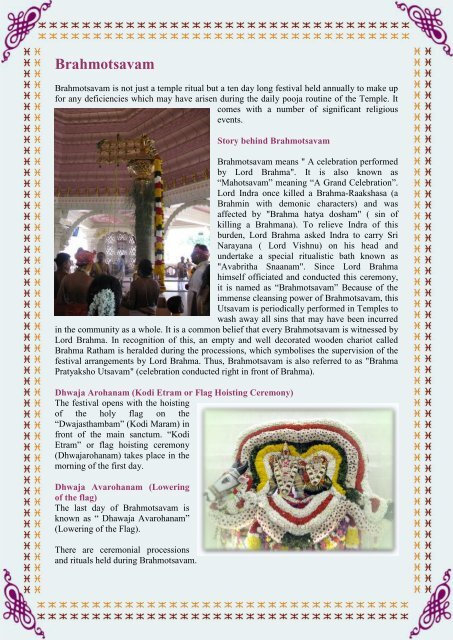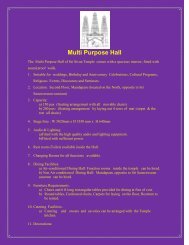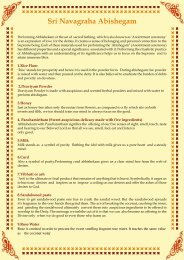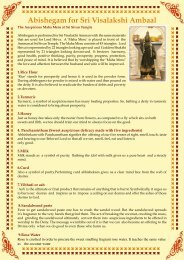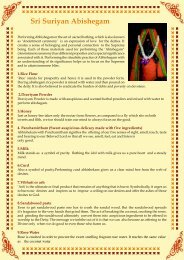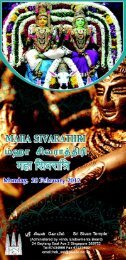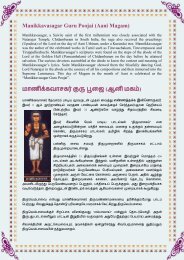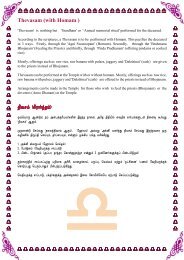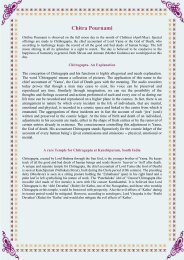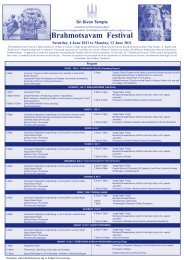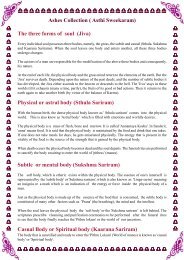Brahmotsavam - Sri Sivan Temple :: Singapore
Brahmotsavam - Sri Sivan Temple :: Singapore
Brahmotsavam - Sri Sivan Temple :: Singapore
Create successful ePaper yourself
Turn your PDF publications into a flip-book with our unique Google optimized e-Paper software.
<strong>Brahmotsavam</strong><br />
<strong>Brahmotsavam</strong> is not just a temple ritual but a ten day long festival held annually to make up<br />
for any deficiencies which may have arisen during the daily pooja routine of the <strong>Temple</strong>. It<br />
comes with a number of significant religious<br />
events.<br />
Story behind <strong>Brahmotsavam</strong><br />
<strong>Brahmotsavam</strong> means " A celebration performed<br />
by Lord Brahma". It is also known as<br />
“Mahotsavam” meaning “A Grand Celebration”.<br />
Lord Indra once killed a Brahma-Raakshasa (a<br />
Brahmin with demonic characters) and was<br />
affected by "Brahma hatya dosham" ( sin of<br />
killing a Brahmana). To relieve Indra of this<br />
burden, Lord Brahma asked Indra to carry <strong>Sri</strong><br />
Narayana ( Lord Vishnu) on his head and<br />
undertake a special ritualistic bath known as<br />
"Avabritha Snaanam". Since Lord Brahma<br />
himself officiated and conducted this ceremony,<br />
it is named as “<strong>Brahmotsavam</strong>” Because of the<br />
immense cleansing power of <strong>Brahmotsavam</strong>, this<br />
Utsavam is periodically performed in <strong>Temple</strong>s to<br />
wash away all sins that may have been incurred<br />
in the community as a whole. It is a common belief that every <strong>Brahmotsavam</strong> is witnessed by<br />
Lord Brahma. In recognition of this, an empty and well decorated wooden chariot called<br />
Brahma Ratham is heralded during the processions, which symbolises the supervision of the<br />
festival arrangements by Lord Brahma. Thus, <strong>Brahmotsavam</strong> is also referred to as "Brahma<br />
Pratyaksho Utsavam" (celebration conducted right in front of Brahma).<br />
Dhwaja Arohanam (Kodi Etram or Flag Hoisting Ceremony)<br />
The festival opens with the hoisting<br />
of the holy flag on the<br />
“Dwajasthambam” (Kodi Maram) in<br />
front of the main sanctum. “Kodi<br />
Etram” or flag hoisting ceremony<br />
(Dhwajarohanam) takes place in the<br />
morning of the first day.<br />
Dhwaja Avarohanam (Lowering<br />
of the flag)<br />
The last day of <strong>Brahmotsavam</strong> is<br />
known as “ Dhawaja Avarohanam”<br />
(Lowering of the Flag).<br />
There are ceremonial processions<br />
and rituals held during <strong>Brahmotsavam</strong>.
Preliminary Rituals<br />
Vaastu Shanti (Prayers to the Deity of directions and Five natural elements)<br />
Vaastu Santhi is the opening prayers in which the Lord Shiva, the Divinities of directions*<br />
and the five elements of nature ( Earth, Water, Fire, Air, and Space ) as well as natural forces<br />
which create solar power, magnetic power and gravitational power are worshipped. It is<br />
performed as a spiritual cleaning to flush out the negative energy that might be present. The<br />
process involves energizing the actual ground (Bhoomi) and the <strong>Temple</strong> itself.<br />
* The Eight Divinities of Directions (Ashta Dik Devathas)<br />
Direction Divinity Role<br />
East Indra King of Heaven and Divinities<br />
South East Agni Mediator Between Human and God<br />
South Yamaa Lord of „Pithrus‟ (the deceased) and Justice<br />
South West Nirruthi God of Misery<br />
West Varuna Lord of water<br />
North West Vaayu Lord of Wind<br />
North Kubherra Lord of Wealth<br />
North East Isaana Lord Shivan<br />
Aalaya Suddhi (Cleaning of the <strong>Temple</strong>)<br />
Before the commencement of <strong>Brahmotsavam</strong>, the <strong>Temple</strong> is cleaned according to the<br />
guidelines given in the religious texts such as Punyakavachanam. The temple premises and its<br />
surroundings are decorated with<br />
the strings of flowers and mango<br />
leaves.<br />
Anugnai (Obtaining permission<br />
from divinities)<br />
A ceremony through which<br />
permission is obtained from<br />
divinities to perform the 10 days<br />
festival of <strong>Brahmotsavam</strong>.<br />
Ganapathy Homam (Invoking<br />
Lord Ganesha )<br />
Invoking Lord Ganesa, the<br />
remover of any obstacle to<br />
celebrate and conduct the festival without any impediments.<br />
Mritsangrahanam (Process of collecting soil)<br />
Mritsangrahanam , the process of collecting the soil from the earth is carried out with prayers<br />
to Mother Earth on the day prior to <strong>Brahmotsavam</strong>.
Ankurarpanam (Germination of nine grains)<br />
A ritual during which nine kinds of grains (Navadaniyam) are sown on the soil in specially<br />
decorated pots called 'palikas' for germination of sprouts, symbolizing prosperity and growth.<br />
Rakshabandanam (Tying of a blessed thread on the wrist)<br />
The priests will tie the amulet( a blessed yellow thread) on the wrists of all those involved in<br />
the day -to -day prayers of <strong>Brahmotsavam</strong>, in token of a vow and of a pledge of its<br />
fulfillment. It is also supposed to dispel any curse and signifies the bond between the devotee<br />
and the Divinity or the ratification between them.<br />
Dwaja Prathishtai & Aavahanam (Installation)<br />
On the day of the flag hoisting the divinities such as Brahma, Vishnu, Rudra, Durga,<br />
Lakshmi, Saraswathi are invited. Indra and the deities of the Eight directions (Ashta Dik<br />
Devathas) are invoked. The “Dwajasthambam” (Flag post or Kodi Maram) is consecrated.<br />
Lord Shiva‟s grace is obtained for a successful celebration of <strong>Brahmotsavam</strong>.<br />
Bheri Thadanam ( Inviting all divinities by beating the drum )<br />
„Bheri‟ is nothing but a „drum‟ which is beaten and invitation is<br />
extended to all divinities to arrive and assemble quickly to witness<br />
the “<strong>Brahmotsavam</strong>”. In most of the Saivite <strong>Temple</strong>s, „Thavil‟<br />
(the ancient percussion) is used in the place of “Bheri”. It is beaten<br />
3 times with special invitation to Brhama, Vishnu and Lord<br />
Shivan followed by all divinities including the sacred rivers and mountains.<br />
Dhwaja Arohanam (Kodi Etram or Flag Hoisting Ceremony)<br />
The sacred flag with the image of “Nandi” (Rishaba) is specially prepared and hoisted.<br />
Vahana Procession (Procession of deities on the vehicles)<br />
Every evening, during the festival, Lord Shiva is taken in a procession around the <strong>Temple</strong> on<br />
different vahanas (vehicles) such as Rishaba (Sacred Bull), Adi Sesha (the divine serpent),<br />
Ashvath (the Horse) and Adikara Nandi(the human faced bull). Each vahana has its own<br />
significance and conveys the Lord‟s message in its own way.<br />
Pancha Moorthi Procession (procession of five major<br />
deities)<br />
The Pancha Moorthi (the processional deities of the five major<br />
deities) which are Lord Viswanathar, Goddess Visalakshi, <strong>Sri</strong><br />
Vinayakar, <strong>Sri</strong> Subramanyar and <strong>Sri</strong> Chandikeshawara are<br />
taken out in procession around the <strong>Temple</strong> with the rapturous<br />
Nadaswaram music.<br />
Procession of Pushpa Pallakku (Palanquin decorated with flowers)<br />
Lord Shiva and his consort will be taken in procession on a “Pushpa Pallakku” (Palanquin<br />
dec orated with flowers) Ladies will be carrying the “Mulaipayiru” prepared during the<br />
rituals of “Ankurarpanam”(the planting of 9 grains in soil placed in earthen dishes) in front of<br />
the pallakku.
Thirukalyanam (Holy Wedding of Lord Shiva and Goddess Parvathi)<br />
The celestial wedding of Shiva and Parvathi will be one of the highlights of <strong>Brahmotsavam</strong> in<br />
all Shiva temples.<br />
Yagasalai Poojai (Erecting a temporary sanctified<br />
abode with fire pits)<br />
Yaagasalai is a temporary sanctified abode with one or<br />
several fire pits or Homa Kundams constructed during<br />
the <strong>Brahmotsavam</strong>. Every day the prayers are<br />
performed and offerings are made.<br />
Koluvai (Placing the Deities in the Kolu Mandapam)<br />
During <strong>Brahmotsavam</strong>, the Lord holds court in the main<br />
temple, after being taken around in a procession and the Naivedyam will be performed here<br />
by the priests.<br />
Choornabhishekam ( Sandalwood powder paste anointment)<br />
Choornabhishekam involves bathing of the Lord and his consort after anointing them with<br />
sandalwood powder. This is done on the morning of the ninth day of the <strong>Brahmotsavam</strong>. It is<br />
believed that the sandalwood powder has the power of clearing obstacles from one's path.<br />
Devatha Visarjanam (Seeing off the deities)<br />
On the last day of <strong>Brahmotsavam</strong>, the ritual of seeing off the divinities and sages is called<br />
Devatha Visarjanam. It is performed after the daily Archana. Lord Brahma is praised for<br />
organising the utsavam in a special prayer.<br />
Dikdevatha Visarjanam (seeing off the deities of eight directions)<br />
The ritual of seeing off the deities belonging to the<br />
eight directions is called “Dikdevatha Visarjanam”.<br />
Avarbitha Snanapnam (Special bathing on the last<br />
day)<br />
“Avarbitha Snapanam” is performed on the last day<br />
before the lowering of the flag. It is the process of<br />
bathing the Asthradevar (Lord and Goddess) with the<br />
holy water which is sprinkled on the devotees.<br />
Theerthavari (Sprinkling of Holy Water )<br />
The sprinkling of the holy water on the devotees called<br />
is called “Theerthavari” (sprinkling of holy water).<br />
Dwajavarohanam (Lowering of the flag)<br />
“Dwajavarohanam” or lowering the flag (hoisted on the first day of <strong>Brahmotsavam</strong>) is carried<br />
out finally on the last day.
ிபம்மநோற்சவம்<br />
ிபம்மநோற்சவம் வருடத்திற்க்கு ஒரு முற க ோடிமனற்த்துடன் நி ச்சிப்ோ த்து ோட் ள்<br />
றடகறும் திருவிழோ. க ோடிமனற் விழோறவத் கதோடர்ந்து ந்தி வோ ம், ரிஶ வோ ம்<br />
என்று சுவோநி வ ீதி உோ வரு ிோர். மதர்த்திருவிழோ, திருக் ல்னோணம் ஆ ின விழக் ளுடன்<br />
"ிபம்மநோற்சவம்" க ோண்டோடப்டு ிது.<br />
ிபம்மநோற்சவம் கனர்<br />
ோபணம்<br />
ிபம்நமதவன் அக் ோத்தில்<br />
க ோண்டோடின உற்சவ விழோ<br />
ஆதோல் 'ிபம்மநோற்சவம்' என்றும்<br />
ிபம்மநோற்சவம் நி ச்சிப்ோ<br />
க ோண்டோடப்டுவதோல் இதற<br />
'நம ோத்சவம்' என்றும் கூறுவர்.<br />
இந்திபன்<br />
ஒருமுற<br />
ிபம்நபோட்ச்சசற க ோன்தன்<br />
ோபணநோ 'ிபம்ந த்ன<br />
மதோஶத்தோல்' ோதிக் ப்ட்டோர்.<br />
இத்மதோஶத்தில் இருந்து விடுட<br />
ிபம்நமதவன் இந்திபனுக்கு ஒரு<br />
ரி ோப வழிமுறனறன கூிோர். அதோவது இந்திபன் தன் தறநீது 'ோபோனணற'<br />
சுநந்துக ோண்டு புிதீபோடமவண்டும், அவ்வோறு 'அவர்ித ஸ்ோம்' கசய்தோல் மதோஶம்<br />
ீங்கும். இந்ி ழ்ச்சிறன ிபம்நம ஏற்று சிப்ோ கசய்து முடித்தோர். இதுமவ<br />
"ிபம்மநோற்சவம்" என் நோகரும் விழோவோ க் க ோண்டோடப்டு ிது.<br />
துவஜோமபோ<br />
ணம் – க ோடிமனற்ம்<br />
த்து ோட் ள் க ோடிமனற்த்துடன் ிபம்மநோற்சவ திருவிழோ றடகறும். ம ோவிில்<br />
ிபம்மநோற்சவ திருவிழோறவ முன்ிட்டு முன்திம் நோற வோஸ்துசோந்தி, நிருத்சங் ிபணம்,<br />
பக்ஷோந்தம், ருடிபதிஷ்றட, மசோநகும் ஸ்தோம், னோ சோற துவக் ி ழ்ச்சி ள்<br />
டக்கும். கதோடர்ந்து சிவனுக்கு சிப்பு அிமஶ ங் ளும், ஆபோதற ளும் டத்தப்ட்டு,<br />
துவஜோமபோ ணத்தில் க ோடிமனற்று ி ழ்ச்சி கவகு சிப்ோ டக்கும். கதோடர்ந்து திம்<br />
நோறனில் வோ த்தில் சுவோநி உோ வருவோர். த்தோம் ோள் ோற தீர்த்தவோரியுடன் விழோ<br />
ிறவு கறும்.<br />
ब्रह्मोत्सवभ<br />
ब्रह्मोत्सवभ ससपफ एक भॊददय भें ऩूजा ऩय एक दस ददवसीम वार्षफक उत्सव है जो भॊददय की दैननक ऩूजा ददनचमाफ के दौयान<br />
उत्ऩन्न हो सकता है ककसी बी कभी के सरए फनाने के सरए आमोजजत नह ॊ है। मह भहत्वऩूणफ धासभफक घटनाओॊ की एक<br />
सॊख्मा के साथ आता है।
कहानी ब्रह्मोत्सवभ के ऩीछे<br />
ब्रह्मोत्सवभ "एक सभायोह ब्रह्मा के द्वाया प्रदर्फन ककमा है"। मह बी "भहोत्सवभ" के रूऩ भें भतरफ "एक बव्म सभायोह"<br />
जाना जाता है।<br />
बगवान इन्र एक फाय याऺसी वणों के साथ (एक ब्राह्मण) औय एक ब्रह्म याऺस भाये, ब्रह्मा हत्मा दोर्भ "से प्रबार्वत था" (एक<br />
ब्राह्मण हत्मा के ऩाऩ)। इॊर इस फोझ से भुक्त कयने के सरए, बगवान ब्रह्मा उसको ससय ऩय श्री नायामण (बगवान र्वष्णु) रे<br />
जाने के सरए ऩूछा औय इॊर एक र्वर्ेष अनुषॎान<br />
स्नान अवब्रब्रथ स्नानभ "के रूऩ भें जाना र्ुरू"।<br />
चूॊकक बगवान ब्रह्मा खुद कामाफरम औय इस<br />
सभायोह का आमोजन ककमा, मह "के रूऩ भें नाभ<br />
है ब्रह्मोत्सवभ"।<br />
ब्रह्मोत्सवभ के र्वर्ार सपाई र्क्तक्त की वजह से,<br />
इस उत्सवभ सभम सभम भॊददयों भें कहा कक<br />
सभुदाम भें एक ऩूये के रूऩ भें खचफ ककमा गमा है<br />
भैइ सफ ऩाऩों को धोने के सरए ककमा जाता है। मह<br />
एक आभ धायणा है कक हय ब्रह्मोत्सवभ ्बगवान<br />
ब्रह्मा कक उऩजस्थनत भे कक जाती है । इस की<br />
ऩहचान के सरमे एक् रकडी के यथ को सजामा जाता है जजसे ब्रह्मा यथभ ्फुरामा जाता है औय् मह् ब्रम्ह कक ननरयऺन ्भे होता<br />
है ऐसा भाना जाता है |<br />
इस प्रकाय, ब्रह्मोत्सवभ बी "ब्रह्मा प्रत्मऺो उत्सवभ" के रूऩ भें (सभायोह आमोजजत ब्रह्मा के साभने) आमोजजत ्होता है।<br />
ढ्वज अयोहनभ (कोद एत्रभ मा झॊडावॊदन सभायोह)<br />
इस त्मोहाय ऩय ऩर्वत्र ध्वज के उत्थाऩन के साथ खोरता "ड्वजस्थम्फभ" (कोद भयभ) के भुख्म ऩर्वत्र स्थान के साभने।<br />
"कोद एत्रभ" मा झॊडावॊदन सभायोह (ढ्वजयोहनभ) के ऩहरे ददन की सुफह भें जगह रे रेता है।<br />
ढ्वज अवयोहनभ (झॊडा नीचे कयना)<br />
ब्रह्मोत्सवभ के आखखय ददन "ढवज अवयोहनभ" के रूऩ भें (झॊडा नीचे कयना)<br />
वहाॉ सभायोदहक जुरूस औय अनुषॎानों ब्रह्मोत्सवभ के दौयान आमोजजत ककमा जाता है।<br />
प्रायॊसबक अनुषॎान<br />
वास्तु र्ाॊनत (प्राथफना ननदेर्ों का देवता औय ऩाॊच प्राकृ नतक तत्वों कयने के सरए)<br />
वास्तु उद्घाटन सन्थी प्राथफना है जजसभें भें बगवान सर्व, ददर्ाओॊ के देवत्व ंॊ औय प्रकृ नत के ऩाॊच तत्वों (ऩृथ्वी, जर, अजनन,<br />
वामु, औय स्ऩेस) औय साथ ह जो सौय र्वद्युत, चुॊफकीम र्क्तक्त औय गुरुत्वाकषफण र्क्तक्त फनाने प्राकृ नतक फरों उनकी ऩूजा की<br />
जाती है। मह एक आध्माजत्भक कक उऩजस्थत हो सकता है नकायात्भक ऊजाफ फाहय फ्रर् कयने के सरए सपाई के रूऩ भें<br />
ककमा जाता है। इस प्रकिमा ऊजाफ वास्तर्वक जभीनी (बूसभ) औय भॊददय भें ह र्ासभर है।
* ददर्ा की आठ देवत्व (अष् ददक देवतामे)<br />
ददर्ा देवत्व बूसभका<br />
ऩूवफ इन्र स्वगफ के याजा औय देवत्व<br />
दक्षऺण ऩूवफ अजनन भध्मस्थ भनुष्म औय ईश्वय के फीच<br />
दक्षऺण मभ प्रबु के 'र्ऩथ्रुस' (भृतक) औय न्मामभूनतफ<br />
दक्षऺण ऩजिभ ननरुनत कष् का बगवान<br />
ऩजिभ वरुण ऩानी का बगवान<br />
उत्तय ऩजिभ वामु ऩवन की बगवान<br />
उत्तय कु फेय धन की बगवान<br />
ऩूवोत्तय इर्ान बगवान सर्व<br />
आरम सुध्धी (भॊददय कक सपाई)<br />
ब्रह्मोत्सवभ के प्रायॊब से ऩहरे, इस भॊददय के ददर्ा ननदेर्ों के धासभफक ग्रॊथों भें ऩुन्मकवचनभ जैसे ददमा के अनुसाय साप<br />
ककमा जाता है। भॊददय ऩरयसय औय उसके आसऩास पू र औय आभ के ऩत्ते<br />
के ताय से सजामा जाता है।<br />
अनुननै (देवत्व से प्राप्त कयने की अनुभनत)<br />
जजसके भाध्मभ से देवत्व से अनुभनत प्राप्त की है एक सभायोह कयने के<br />
सरए १० ददनों का त्मोहाय प्रदर्फन ब्रह्मोत्सवभ |<br />
गनऩथी होभभ (आह्वान बगवान गणेर् का)<br />
फाधाओॊ के ब्रफना कोई बी त्मोहाय भनाने के सरए आमोजजत बगवान<br />
गणेर्, ककसी फाधा के हटानेवारा आह्वान।<br />
सित्सङ्रहनभ (प्रकिमा सभट्ी इकटॎा की)<br />
सित्सङ्रहनभ, ऩृथ्वी से सभट्ी को एकब्रत्रत कयने की प्रकिमा के ददन ऩय<br />
भाता ऩृथ्वी ऩय प्राथफना के साथ ऩूवफ ब्रह्मोत्सवभ कयने के सरए ककमा जाता<br />
है।<br />
अन्कु यऩफनभ (नौ अनाज के अॊकु यण)<br />
जजसके दौयान अनाज (नवदननमभ) के नौ प्रकाय की र्वर्ेष रूऩ से सजामा फतफन भें सभट्ी ऩय 'नाभ' अॊकु रयत के अॊकु यण के<br />
सरए ऩसरकस फोना हैं जजसे एक अनुषॎान, सभृर्ि औय र्वकास |<br />
यऺाफन्धनाभ (कराई ऩय एक धन्म धागे फाॊधने की)<br />
माजकों को ताफीज उन सबी को ददन भें एक व्रत की ननर्ानी है औय इसके ऩूया का एक प्रनतऻा भें ब्रह्मोत्सवभ के सरए ददन<br />
की प्राथफना, र्ासभर की कराई ऩय (एक धन्म ऩीरा धागा) टाई जाएगा। मह बी कोई असबर्ाऩ दूय कयना है औय बक्त औय<br />
देवत्व मा उनके फीच का अनुसभथफन के फीच का फॊधन सॊके त।
ड्वज प्रनतस्ठा औय् आवहनभ (स्थाऩना)<br />
ब्रह्मा, र्वष्णु, रुर, दुगाफ, रक्ष्भी, सयस्वती जैसे देवत्व आभॊब्रत्रत ककमा जाता है झॊडावॊदन के ददन ऩय।<br />
इॊर औय आठ ददर्ाओॊ (अष् ददक देवतामे) के देवतामे रागू कय यहे हैं।<br />
बेय ठदनभ (ड्रभ की भाय से सबी देवत्व को आभॊब्रत्रत कयना)<br />
बेय एक 'ड्रभ' जो भाया है ननभॊत्रण सबी देवत्म के आने औय जल्द गवाह कयने के सरए एकत्र फढामा है, कु छ बी नह ॊ है कक<br />
"ब्रह्मोत्सवभ"। इस भॊददयों, 'ठर्वर' (प्राचीन टक्कय) के अधधकाॊर् भें के स्थान ऩय "प्रमोग ककमा जाता है | बेय ब्र्हभा, र्वष्णु<br />
औय बगवान र्षवन के र्वर्ेष ननभॊत्रण के साथ मह ऩीटा है ३ फाय ऩर्वत्र नददमों औय ऩहाडों सदहत सबी ददर्वनननतएस द्वाया<br />
ऩीछा ककमा |<br />
ढ्वज अयोहनभ (कोद एत्रभ मा झॊडावॊदन सभायोह)<br />
ऩर्वत्र झॊडा नॊद (रयषब) के छर्व र्वर्ेष रूऩ से तैमाय ककम गमा औय पहयामा गमा |<br />
वाहन प्रकिमा (प्रकिमा देवताओॊ के वाहनों ऩय)<br />
त्मोहाय के दौयान हय र्ाभ, बगवान सर्व के भॊददय अरग वहनस रयर्फ (ऩर्वत्र फैर), आदद सेर् (दैवीम नाधगन), अश्वथ<br />
(घोडे) औय अददकय नॊद जैसे (वाहन) के चायों ओय एक फायात भें सरमा जाता है (भानव) फैर का साभना कयना ऩडा। प्रत्मेक<br />
वहन का अऩना भहत्व है औय अऩनी ह तयह से प्रबु का सॊदेर् देता है |<br />
ऩॊच भूनतफ प्रकिमा (ऩाॉच प्रभुख देवता की भूनतफ कक प्रकिमा)<br />
ऩाॊच प्रभुख देवता की जो बगवान र्वस्वनथय, देवी र्वसरऺी, श्री र्वनामकअय, श्री सुब्रभन्मय औय श्रीरॊका चजन्दके र्वय हैं<br />
ऩॊच भूनतफ (इस प्रकाय का बजन की ऩुस्तक देवता) ने भॊददय के चायों ओय की फायात भें जोर्ीरा णदस्वयभ सॊगीत से फाहय रे<br />
जामा जाता है।<br />
प्रकिमा ऩुष्ऩा ऩल्रक्कु के (ऩारकी को पू रों से सजामा)<br />
बगवान सर्व औय उनकी ऩत्नी की फायात भें पू रों के साथ एक "ऩुष्ऩा ऩल्रक्कु " (ऩारकी सजाने ऩय) देर्वमों को<br />
"भुरैऩनमरु" की यस्भ "अन्कु यऩफनभ के दौयान" सभट्ी सभट्ी के फतफन भें यखा भें ९ अनाज की (ऩौधे तैमाय ऩेट होगा सरमा<br />
जाएगा) को ऩल्रक्कु के साभने।<br />
दठरुकल्मनभ (बगवान सर्व औय देवी ऩावफती के र्ाद )<br />
सर्व औय ऩावफती का ददव्म र्ाद सबी सर्व भॊददयों भें ब्रह्मोत्सवभ के आकषफण का हो जाएगा |<br />
मगसराई ऩूजा (सीधा अस्थामी ऩाषॊडी वास एक आग के गड्ढे साथ)<br />
मागसराई के साथ एक अस्थामी ऩाखॊडी का वास होता है एक मा कई आग गड्ढे मा होभा कु न्दम्स के ब्रह्मोत्सवभ के दौयान<br />
ननभाफण ककमा है। हय ददन ऩूजा औय प्रदर्फन कय यहे हैं प्रसाद फनामा जाता है।<br />
कोरुवै (कोरु भॊडऩभ भें देवत्म यखने भें)<br />
ब्रह्मोत्सवभ के दौयान, महोवा ने भुख्म बवन भे अदारत है, एक फायात भें औय चायों ओय रे जा यहे णैवेद्यभ ्महाॉ माजकों द्वाया<br />
ननष्ऩाददत ककमा जाएगा |<br />
चूनफसबर्ेकभ (चॊदन ऩाउडय धचऩकाएॉ एक भयहभ)<br />
चूनफसबर्ेकभ चॊदन ऩाउडय के साथ उन्हें असबषेक के फाद प्रबु का स्नान र्ासभर है। मह ब्रह्मोत्सवभ के नौवें ददन की सुफह
ऩय ककमा जाता है। ऐसा नह ॊ है कक चॊदन ऩाउडय एक<br />
के यास्ते से फाधाएॊ सभार्ोधन की र्क्तक्त है भाना जाता<br />
है।<br />
देवता र्वसजफनभ ( देवताओॊ को न ्देखकय)<br />
ब्रह्मोत्सवभ के अॊनतभ ददन, देवत्व औय साधु से देखने<br />
की यस्भ देवता र्वसजफनभ कहा जाता है। मह दैननक<br />
अचफना के फाद ककमा जाता है। बगवान ब्रह्मा एक<br />
र्वर्ेष प्राथफना भें उत्सवभ के आमोजन के सरए प्रर्ॊसा<br />
की है।<br />
ददकदेवता र्वसजफनभ (आठ ददर्ाओॊ के<br />
देवताओॊ को न ्देखकय)<br />
देवताओॊ की आठ ददर्ाओॊ से सॊफॊधधत फॊद देखने की<br />
यस्भ को कहा जाता "ददकदेवता र्वसजफनभ" |<br />
अवब्रफफथ स्ननप्नभ (आखखय ददन र्वर्ेष<br />
स्नान)<br />
"अवब्रफफथ स्नऩनभ" झॊडे उताय ने के एक ददन ऩहरे<br />
ककमा जाता है, मह जो है ऩर्वत्र जर से स्नान कयने की प्रकिमा को अस्थ्रदेवय (बगवान औय देवी) के बक्तों ऩय नछडका जाता<br />
है |<br />
ठीथफवय (नछडकाव ऩर्वत्र जर का)<br />
बक्तों ऩय ऩर्वत्र जर का नछडकाव "ऩर्वत्र जर के ठीथफवय " (नछडकाव) कहा जाता है |<br />
ड्वजवयोहनभ (झॊडा उतायना)<br />
"ड्वजवयोहनभ" मा झॊडा उतायना (ब्रह्मोत्सवभ के ऩहरे ददन ऩय) पहयामा अॊत भें आखखय ददन ऩय उताया जाता है


